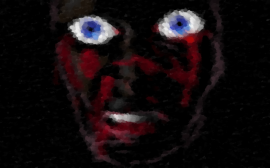This is another thing I don’t think I’ve talked about how it works yet. Though this is actually another one of those musings for how I would like to change and refine my current system for its next incarnation. As I might have mentioned however, Darkest Nights is both a quite narrative/descriptive system, and a decently realistic one (on the non-supernatural side), so I definitely don’t want to just use a hit point system. Wounds just carry too much narrative potential, and hit point bloat is completely wrong for the feel of the game. Thus, I’ll try to create a light but effective injury system.

The system I’m using is a split between a buffer and actual injuries. This isn’t particularly innovative in itself, but I’m trying to balance it to reach the proper level of detail while still keeping it fast and simple. Insanity and mental damage is saved for another post, as they are at least equally important in a horror campaign as physical damage is.
Grit
Grit is actually the hit points of the system. Or more specifically, stamina, willpower, skill, luck, instinct, and a lot more little things in a cocktail that allows you to avoid serious harm. Reduction represents physical and mental fatigue.
You currently start out with 4 points of Grit, and can gain 4-5 more if you spend Insight to improve it. You recover half your maximum after a good meal and a night’s sleep.
Damage
At the moment some weapons do 1d4 or 1d8 damage, but I’m very much thinking of turning the system to d6-only. That would still work perfectly well. The damage capacity would then fall into the 1-6 range for hand weapons, giving us a constrained reach of numbers. Probability would be shifted by rolling multiple dice and taking one.
Injury
Injury would be caused when you completely fail to avoid an source of damage. That will cause a wound with a severity equal to the damage taken. You can reduce the severity by spending Grit at a one-to-one ratio, escaping otherwise lethal injury. Here’s the new wound table. Each effect up to the damage recieved is applied.
- Staggered. Loose your next action if in a battle situation, otherwise loose some time.
- Flesh wound. No additional effect except making you more suspectible to infection.
- Bleeding wound. You loose one Grit per minute until you pass out a minute after 0.
- Crippling wound. The hit body part is rendered useless until healed.
- Mortal wound. You can crawl around and die fast, or chill and die slower.
- Death wound. You immediately die, whether bloodily or silently.
You do, in addition to the injury, loose Grit equal to half the damage recieved, rounded up. You can “buy down” your injury by spending additional Grit, 1 point per step, up to the full damage number recieved. Thus, any injury can only be reduced a maximum of three steps.
I think this is it for now. I’ll think this over more, but we’ll see if it changes a lot. I’m thinking over Darkest Nights quite a bit at the moment, as I want to “patch” it, fixing the problems, adding and removing needed or needless bits, and just plain polishing up a bit. Hopefully I can make a complete pdf that I can publish here, in case anyone’s interested.
You could make weapons only affect damage types and reach, and maybe only occasionally have weapons affect damage, thus using skill level for the majority of combat damage, ex number of diec?
LikeLike
Thanks for the input! That’s a good way to do it, probably. I’m already simplifying these wound levels to just three, so additional variance in the damage after a hit has occurred feels bad. I’m strongly considering basing damage purely on margin of victory in a combat test at the moment… Time to come up a few interesting weapon properties apart from reach, I guess :p
LikeLike
Oh I know, 3 different barbed properties 😛
Basic barbed, hocked, barbed handle +5 to enrage,
LikeLike